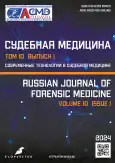On the issue of ensuring the protection of personal data by chipping: a review
- Authors: Amirov A.M.1, Begaliyev Y.N.1, Baimakhanov A.A.1, Bakhteev D.V.2
-
Affiliations:
- Academy of Law Enforcement Agencies Under the General Prosecutors Office of the Republic of Kazakhstan
- Ural State Law University named after V.F. Yakovlev
- Issue: Vol 10, No 1 (2024)
- Pages: 56-67
- Section: Reviews
- URL: https://journals.rcsi.science/2411-8729/article/view/254427
- DOI: https://doi.org/10.17816/fm16096
- ID: 254427
Cite item
Full Text
Abstract
This article presents the results of research regarding the chipping of certain types of persons.
The authors aimed to determine the effectiveness of this mechanism for protecting personal data, as an examination tool, and for medical purposes.
The norms of the legislation of Kazakhstan and foreign countries concerning chipping, scientific publications on the subject, and the conduct of expert examinations were studied. Studies in which the problems of computer-technical examinations and successful application of the newest technologies in medicine and forensic medical examinations were singled out. Notably, there are no holistic studies concerning the possibility of chipping citizens or the application of this technology in various aspects, including forensic examinations.
According to research results, generalization of scientists’ works, and analysis of legislation, chipping of individual citizens was proposed. In this study, SWOT analysis of the issues related to the chipping of certain types of persons for the protection of personal data and for other purposes was performed. The strengths, weaknesses, opportunities, and threats to the implementation of this technology were considered.
Based on the analysis and research of the legislation, chipping of law enforcement officers, civil servants, employees of organizations that have access to state databases of personal data, and employees of organizations that are the owner or operator of non-state databases has been proposed. The proposed mechanism has several advantages and may increase security, reduce unauthorized access to information, and minimize the probable unlawful manifestations in relation to personal data and data with limited access.
Full Text
##article.viewOnOriginalSite##About the authors
Almas M. Amirov
Academy of Law Enforcement Agencies Under the General Prosecutors Office of the Republic of Kazakhstan
Author for correspondence.
Email: han1k1986@mail.ru
ORCID iD: 0000-0002-9960-9339
SPIN-code: 2346-7009
Kazakhstan, Koshy
Yernar N. Begaliyev
Academy of Law Enforcement Agencies Under the General Prosecutors Office of the Republic of Kazakhstan
Email: ernar-begaliev@mail.ru
ORCID iD: 0000-0001-6659-8576
SPIN-code: 1929-3392
Dr. Sci. (Legal), Professor
Kazakhstan, KoshyArtur A. Baimakhanov
Academy of Law Enforcement Agencies Under the General Prosecutors Office of the Republic of Kazakhstan
Email: drartur@list.ru
ORCID iD: 0000-0002-8673-8000
SPIN-code: 9160-2394
Dr. Sci. (Legal)
Kazakhstan, KoshyDmitry V. Bakhteev
Ural State Law University named after V.F. Yakovlev
Email: dmitry.bakhteev@gmail.com
ORCID iD: 0000-0002-0869-601X
SPIN-code: 8301-7165
Dr. Sci. (Legal), Associate Professor
Russian Federation, EkaterinburgReferences
- Kolistratov MV, Vereskun AK. Modern ideas about the methods of application of implantable microelectronic devices. E-Scio. 2023;(7):189-198. (In Russ). EDN: KSEDLU
- Alikperov HD. Global remote crime control: acceptability, opportunities, costs. Criminology: yesterday, today, tomorrow. 2016;(3):26-33. (In Russ). EDN: WWRTDB
- Tyurin IV. Remote control over crime. Is it possible? Criminology: yesterday, today, tomorrow. 2017;(1):44-46. (In Russ). EDN: ZBFTSL
- Borisov DN, Sivashchenko PP, Kushnirchuk II, Rodionov EO. Improving approaches to organizing drug care based on RFID technology. Pharmacoeconomics: theory and practice. 2019;7(1):23. EDN: CIQNZR doi: 10.30809/phe.1.2019.3
- Gainelzyanova VR. Possibilities of forensic computer-technical examination in the investigation of crimes in the field of computer information. Bulletin of Ufa law institute. 2021;(1):144-149. EDN: LMFXEE
- Lantukh EV, Ishigeev VS, Gribunov OP. The use of special knowledge in the investigation of computer crimes. Russian journal of criminology. 2020;14(6):882-890. EDN: VHTUKP doi: 10.17150/2500-4255.2020.14(6).882-890
- Sysenko AR, Smirnova IS, Timoshenko SE. Problems of appointment and production of forensic computer-technical expertise. Siberian law review. 2020;17(4):523-533. EDN: GOOZQR doi: 10.19073/2658-7602-2020-17-4-523-533
- Koshelev DA Timchenko TV. Possibility of using cloud and fog technologies for monitoring the health of military personnel. In: Radiolocation, Navigation, Communication: Proceedings of the XXV International Scientific and Technical Conference dedicated to the 160th anniversary of A.S. Popov. 2019. Vol. 1. Р. 114-123. (In Russ). EDN: WAVBLH
- Kupriyanova IA, Zhavoronkova AA. Artificial intelligence in the health care system: analysis, planning and programme solutions. In: Formation of mechanisms of sustainable economic development: Proceedings of the III All-Russian (with international participation) scientific-practical conference. Simferopol; 2023. Р. 277-282. (In Russ). EDN: XANOZC
- Nedugov GV. New computer technologies to determine postmortem interval by the Henssge method. Russ J Forensic Med. 2021;7(3):152-158. EDN: NLBPEN doi: 10.17816/fm406
- Leonov SV, Shakiryanova YP, Pinchuk PV. Development prospects of 3D modelling in forensic medicine: Bim-technology and 4D modelling. Russ J Forensic Med. 2020;6(1):4-13. EDN: TDKORK doi: 10.19048/2411-8729-2020-6-1-4-13
- Klevno VV, Chumakova YV, Pavlik DP, Dubrova SE. Potential of the virtual autopsy in case of firearm injury. Russ J Forensic Med. 2019;5(3):33-38. EDN: PMIIDQ doi: 10.19048/2411-8729-2019-5-3-33-38
- Orakbayev AB, Kurmangali ZhK, Begaliyev YeN, et al. ON The issue of using the results of a virtual autopsy in criminal investigation: A review. Russ J Forensic Med. 2023;9(2):183-192. EDN: OEERGD doi: 10.17816/fm774
- Bakhteev DV. Artifiial intelligence in forensic science: Current state and application potential. Russian Law: Education, practice, researches. 2018;(2):43-49. EDN: XSESHB
- Voyevodkin DV, Rustemova GR, Begaliyev YN, et al. Identifying fake conclusions of forensic medical examinations using an artificial intelligence technology based on the experience in the Republic of Kazakhstan: A review. Russ J Forensic Med. 2023;9(3):287-298. EDN: EFNJIE doi: 10.17816/fm8270
- Shchastny AT, Mikhnevich EV. Achievements and problems of transplantology at the present stage. Vestnik Vitebskogo Gosudarstvennogo Meditsinskogo Universiteta. 2018;17(5):7-16. EDN: YLHIBF doi: 10.22263/2312-4156.2018.5.7
Supplementary files













